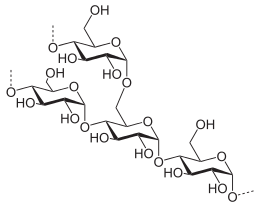Amylopectin
 | |
| Identifiers | |
|---|---|
| 9037-22-3 | |
| ECHA InfoCard | 100.029.907 |
| EC Number | 232-911-6 |
| PubChem | 439207 |
| UNII | 4XO4QFV777 |
| Properties | |
| variable | |
| Molar mass | variable |
| Appearance | white powder |
| Except where otherwise noted, data are given for materials in their standard state (at 25 °C [77 °F], 100 kPa). | |
| | |
| Infobox references | |

Amylopectin /ˌæmᵻloʊˈpɛktᵻn/ is a soluble[1][2] polysaccharide and highly branched polymer of glucose found in plants. It is one of the two components of starch, the other being amylose.
Glucose units are linked in a linear way with α(1→4) glycosidic bonds. Branching takes place with α(1→6) bonds occurring every 24 to 30 glucose units, resulting in a soluble molecule that can be quickly degraded as it has many end points onto which enzymes can attach. In contrast, amylose contains very few α(1→6) bonds, or even none at all. This causes amylose to be hydrolyzed more slowly, but have higher density and be insoluble.
Its counterpart in animals is glycogen, which has the same composition and structure, but with more extensive branching that occurs every eight to 12 glucose units.
Plants store starch within specialized organelles called amyloplasts. When energy is needed for cell work, the plant hydrolyzes the starch, releasing the glucose subunits. Humans and other animals that eat plant foods also use amylase, an enzyme that assists in breaking down amylopectin.
Starch is made of about 70% amylopectin by weight, though it varies depending on the source (higher in medium-grain rice to 100% in glutinous rice, waxy potato starch, and waxy corn, and lower in long-grain rice, amylomaize, and russet potatoes, for example). Amylopectin is highly branched, being formed of 2,000 to 200,000 glucose units. Its inner chains are formed of 20-24 glucose subunits.
Dissolved amylopectin starch has a lower tendency of retrogradation (gelling) during storage and cooling. For this main reason, the waxy starches are used in different applications mainly as a thickening agent or stabilizer.
See also
- Glycogenosis type IV
- 'Amflora', a genetically modified potato high in amylopectin (low in amylose) with a high glycemic index
- 'Waxy corn', a Chinese maize with almost all amylopectin and trace amounts of amylose, different from normal corn which endosperm contains 25% amylose
References
- ↑ "Amylose, Amylopectin (starch)". GMO Compass. Archived from the original on 31 December 2010. Retrieved 2011-02-07.
- ↑ Green, Mark M.; Blankenhorn, Glenn; Hart, Harold (November 1975). "Which Starch Fraction is Water-Soluble, Amylose or Amylopectin?". Journal of Chemical Education. 52 (11): 729. doi:10.1021/ed052p729. Subscription required for online access.